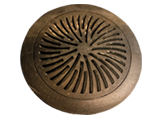HOW TECH TICKS
One evening in late July, the daytime clamor of ongoing construction at the Moss Arts Center gave way to some unexpected noisemakers: party balloons, a starter pistol, and a dodecahedron speaker and sub-woofer.
In a process called acoustical commissioning, consultants from Arup, a New York firm, were measuring the sound in the Anne and Ellen Fife Theatre in the Street and Davis Performance Hall. The firm was selected was selected in 2008 to design the center's acoustic and audio systems, and Arup's Matt Mahon and Denis Blount have visited Blacksburg about once a month, testing and retesting the hall's acoustics as the building took shape.
They're pursuing a perfect sound. "Acoustic excellence has been the goal for everyone on the project team," Blount said. "Everything points to A-plus on acoustics. It will be a world-class acoustic music experience."
1. The consultants measured "impulse" responses. An impulse is a sound emitted into a space, and an impulse response is what is perceived in the space. The reverberation time is how long it takes for an impulse to decay by 60 decibels. If the space is too "dry," the reduction will occur before approximately two seconds elapse, meaning that the space absorbs sound too quickly. If the space is too "wet," surfaces are reflecting too much sound. Orchestra sound, for instance, is meant to reverberate more.
2. A sound simulation, courtesy of Arup, displays the behavior of an impulse over the first 200 milliseconds. Simulations help the consultants visualize the spatial perception of acoustics—where the sound is coming from and how enveloped the listener feels.

3. Blount and Mahon measured the room response of each balloon pop and pistol blank using a variety of microphones positioned around the theatre, returning to the exact same seats from earlier visits. Multiple measurements were taken, as "all balloon pops are not the same, and all starter pistol shots are not the same," Blount said.
4. Those are specially calibrated acoustical balloons, right? Nope. The consultants bought them at a party store—and then manually inflated them while standing on the stage. Mahon rhythmically breathed into one balloon, growing light-headed. "And that's how Matt passed out in front of a video crew," he said with a laugh.
5. Also resting on the stage was a case holding two .38 Specials—six-shooters modified to be starter pistols. Ear protection was a necessity; the concussion after the pistol's firing reverberated through the chest cavity of an observer standing nearby.
 6. The third noisemaker was the dodecahedron speaker and a sub-woofer, which emit what's known as a frequency sweep. Cascading from low notes to high, the sweep allows the consultants to measure every possible note that audience members will hear—from 30 hertz, near the bottom of the range the human ear can detect, up through 22.5 kilohertz, slightly above what humans can hear.
6. The third noisemaker was the dodecahedron speaker and a sub-woofer, which emit what's known as a frequency sweep. Cascading from low notes to high, the sweep allows the consultants to measure every possible note that audience members will hear—from 30 hertz, near the bottom of the range the human ear can detect, up through 22.5 kilohertz, slightly above what humans can hear.

7. The hall is filled with acoustically designed features, from the shapes of the balconies and the proscenium down to the plenums under the seats that quietly circulate air.
8. A significant variable is the seats—and how many people are in them. Even winter or summer clothing on members of the audience makes a difference.
9. Arup has worked with the center's production staff to help them learn how to adjust the hall's sound according to the performance and the audience. Two primary methods are available. Acoustic drapery, horizontally deployed on a chain-driven system, can cover reflective surfaces on all levels. With adjustable angles, the orchestra shell can seal off the proscenium, yielding a concert hall.
Produced by University Relations